MEHP impairs male reproductive function through the lipid metabolism pathway: Evidence from in vitro human immature testis culture
IF 3.9
3区 医学
Q2 FOOD SCIENCE & TECHNOLOGY
引用次数: 0
Abstract
Di-(2-ethylhexyl) phthalate (DEHP) is a widely used industrial plasticizer whose main metabolite in the body is mono-(2-ethylhexyl) phthalate (MEHP). The reproductive toxicity of DEHP and MEHP has been documented in some studies. However, precise mechanisms remain unclear, and most research has focused on animal models. In this study, an in vitro culture system of immature human testicular tissue was employed to explore the etiological link between MEHP and developmental toxicity in immature human testes. The examination of micro-morphology, subcellular structure and testosterone secretion demonstrated that immature human testicular tissue could grow best at the temperature of 34 °C in this in vitro culture system. MEHP exposure damaged organelles, reduced testosterone secretion, disrupted oxidative stress and autophagy expression levels. Transcriptome sequencing revealed that differentially expressed genes (DEGs) were mainly associated with lipid metabolism pathways, which indicated the key role of DEGs in MEHP-induced reproductive toxicity. In the current study, the toxicological mechanisms of MEHP were investigated using an in vitro model of immature human testicular tissue. The lipid metabolism pathway could be a critical molecular pathway involved. This study offers a theoretical basis for understanding toxic damage from environmental toxins.
MEHP通过脂质代谢途径损害男性生殖功能:来自体外人类未成熟睾丸培养的证据
邻苯二甲酸二(2-乙基己基)酯(DEHP)是一种广泛使用的工业增塑剂,其在体内的主要代谢物是邻苯二甲酸一(2-乙基己基)酯(MEHP)。DEHP和MEHP的生殖毒性已在一些研究中得到证实。然而,确切的机制尚不清楚,大多数研究都集中在动物模型上。本研究通过体外培养未成熟人睾丸组织,探讨MEHP与未成熟人睾丸发育毒性之间的病因学联系。显微形态学、亚细胞结构和睾酮分泌检测表明,在该体外培养体系中,未成熟的人睾丸组织在34℃的温度下生长最好。MEHP暴露损伤细胞器,降低睾酮分泌,破坏氧化应激和自噬表达水平。转录组测序显示,差异表达基因(DEGs)主要与脂质代谢途径相关,这表明DEGs在mehp诱导的生殖毒性中起关键作用。本研究采用体外未成熟人睾丸组织模型研究MEHP的毒理学机制。脂质代谢途径可能是其中一个关键的分子途径。本研究为认识环境毒素的毒性损害提供了理论基础。
本文章由计算机程序翻译,如有差异,请以英文原文为准。
求助全文
约1分钟内获得全文
求助全文
来源期刊

Food and Chemical Toxicology
工程技术-毒理学
CiteScore
10.90
自引率
4.70%
发文量
651
审稿时长
31 days
期刊介绍:
Food and Chemical Toxicology (FCT), an internationally renowned journal, that publishes original research articles and reviews on toxic effects, in animals and humans, of natural or synthetic chemicals occurring in the human environment with particular emphasis on food, drugs, and chemicals, including agricultural and industrial safety, and consumer product safety. Areas such as safety evaluation of novel foods and ingredients, biotechnologically-derived products, and nanomaterials are included in the scope of the journal. FCT also encourages submission of papers on inter-relationships between nutrition and toxicology and on in vitro techniques, particularly those fostering the 3 Rs.
The principal aim of the journal is to publish high impact, scholarly work and to serve as a multidisciplinary forum for research in toxicology. Papers submitted will be judged on the basis of scientific originality and contribution to the field, quality and subject matter. Studies should address at least one of the following:
-Adverse physiological/biochemical, or pathological changes induced by specific defined substances
-New techniques for assessing potential toxicity, including molecular biology
-Mechanisms underlying toxic phenomena
-Toxicological examinations of specific chemicals or consumer products, both those showing adverse effects and those demonstrating safety, that meet current standards of scientific acceptability.
Authors must clearly and briefly identify what novel toxic effect (s) or toxic mechanism (s) of the chemical are being reported and what their significance is in the abstract. Furthermore, sufficient doses should be included in order to provide information on NOAEL/LOAEL values.
 求助内容:
求助内容: 应助结果提醒方式:
应助结果提醒方式:


